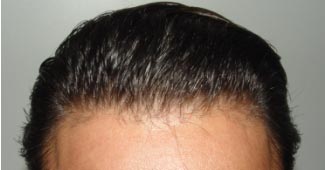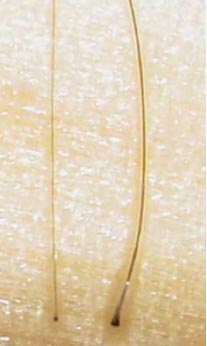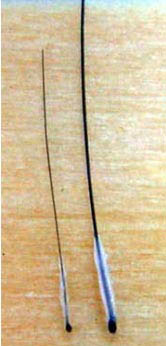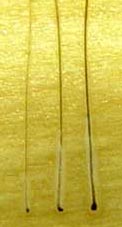|
Ultrafine single hairs
The challenge
for every doctor who works in this area is
to offer results that are increasingly natural
and perfect, and to do so, many details must
be taken into consideration. However, in our
opinion, the greatest challenge continues
to be the hairline, the first five to six
front lines, those that will be most noticed
at first glance.
How can an absolutely natural hairline be
offered, that cannot be detected as a hair
transplant under any circumstances? Our response
is simple. By imitating nature, that is, creating
a hairline exactly like someone who is not
bald, the hairline that the patient would
have had he not suffered hair loss.
If however we wish to imitate nature to the
greatest possible degree and in the manner
in which it appears, we must create those
fine, feathery hairs naturally present in
the first lines.

* hairline
of a person who has not had a hair transplant
To do
so we need finer, more sophisticated hairs.
Five years ago, we isolated these fine hairs
from the others when separating the follicular
units. We coined them ultrafine single hairs.
 Ultrafine
– Fair hair
Ultrafine
– Fair hair |
 Dark
hair
Dark
hair |
What
are these ultrafines?
None other than the finest single hair follicular
units found in the donor area.
 Fair
hair
Fair
hair |
 Dark
hair
Dark
hair |
*note
the difference between the normal single
hairs to the right, those of medium
thickness in the middle and the ultrafines
to the left, removed from the same patient,
in each case. |
How
are ultrafines obtained?
After removing the donor area, we separate
the grafts into four distinct groups: single
hairs, 2-hair FUs, 3-hair FUs and ultrafines.
 Fragment
of the scalp transversally cut and magnified
by a microscope.
Fragment
of the scalp transversally cut and magnified
by a microscope. |
 Follicular
Units separated
Follicular
Units separated |
We isolate
the ultrafines from the normal single hairs
and at the end of the surgery we have a total
number of ultrafines. In general, only 2 to
5% of the single hairs are ultrafines. This
percentage varies from patient to patient
depending on the type of hair from the donor
area. Patients with thick, curly and dark
hair tend to have a fewer number of single
hairs than those patients with fine, straight,
fair hair. Identifying ultrafines from normal
single hairs is possible only using a high-powered
microscope, with 50X magnification. Using
magnifying glasses or less powerful microscopes,
this division would be impossible because
it would not be possible to distinguish them
from normal hairs.

How
and where are they placed?
At the end of surgery, they are distributed
in front of the others to create a transitional
zone, resulting in that feathery aspect characteristic
of persons who have not undergone hair transplant
surgery.
In which cases
should we use ultrafines?
We have utilized ultrafines for all of our
patients, but they are particularly important
for repair cases, when redoing the front region,
of patients with dark, thick hair.
Please
contact us for further information:
info@rustonclinic.com
|